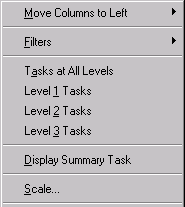| The PM Procedure |
| Project Hierarchy |
The PM procedure displays a hierarchical project structure if it is invoked with the PROJECT statement. If the procedure is invoked without a PROJECT statement, the supertask and subtask relationship is not supported, and all the activities are considered to be at the same level, belonging to a single project. Note that, in the PROJMAN application, the PM procedure is always invoked with the PROJECT statement. See Chapter 8, The Projman Application, for details.
If the PROJECT statement is used, then a task’s level in the project hierarchy is indicated in the Table View by small square boxes to the left of the activity number in the Job Nbr. column. Empty boxes indicate that the activity does not have any subtasks (it is a leaf activity), while filled boxes indicate that the activity is a supertask. Further, a Project Summary task is included to represent the root task (or Summary Task) of the project. This task is positioned at the top of the list of activities, and its display can be toggled on or off by selecting Display Summary Task from the View menu (see Figure 5.7).

In the Gantt View, supertasks are indicated by vertical cones at the end of their corresponding schedule bars.
Note that the durations of the supertasks are determined by the overall duration of their subtasks. Thus, you cannot change the duration of a supertask.
If there is no PROJECT statement, all menu selections that correspond to the multi-project structure are unavailable for selection. For example, the Display Summary Task selection in Figure 5.7 will appear dimmed.
Copyright © SAS Institute, Inc. All Rights Reserved.